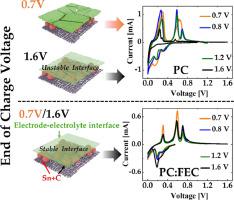Energy Storage Materials ( IF 18.9 ) Pub Date : 2021-09-11 , DOI: 10.1016/j.ensm.2021.09.014 Susmita Sarkar 1 , Partha P. Mukherjee 1

|
Alloying electrodes, such as tin (Sn), are promising candidates for sodium-ion batteries because of their high specific capacity, electronic conductivity, and low sodium insertion voltage. However, sizeable volumetric change and electrode-electrolyte interface evolution in Sn preclude prolonged performance. The electrochemical potential window, compounded by the choice of electrolyte and additive combination, plays a critical role in the interface instability, which yet remains unresolved. This study, based on a comprehensive set of electrochemical, microscopy, and spectroscopic analyses, sheds light into the interface instability and reveals that the use of fluoroethylene carbonate additives in carbonate-based electrolytes can dramatically improve the interface stability of such alloying anodes. Electrochemical and morphological analyses show that without the additive, a higher end-of-charge voltage can cause breakdown and reformation of an unstable passivating layer, leading to rapid electrochemical performance decay. A novel three-electrode-based analytics reveals that superior interphase stability with higher microstructural integrity of the Sn electrode can alleviate the detriments from the upper cut-off voltage restrictions. Addressing the hitherto unresolved role of the electrochemical potential window, this study comprehensively examines and elucidates the causality of interfacial instability and the underpinnings of electrochemical complexations in sodium-alloying anodes.
中文翻译:

协同电压和电解质介导改善 μ-Sn 合金阳极中的钠化动力学
合金电极,如锡 (Sn),由于其高比容量、电子导电性和低钠插入电压,是钠离子电池的有希望的候选材料。然而,Sn 中相当大的体积变化和电极-电解质界面演变阻碍了性能的延长。电化学电位窗口,加上电解质和添加剂组合的选择,在界面不稳定性中起着关键作用,但仍未解决。这项研究基于一套全面的电化学、显微镜和光谱分析,揭示了界面不稳定性,并揭示了在碳酸盐基电解质中使用氟代碳酸亚乙酯添加剂可以显着提高此类合金阳极的界面稳定性。电化学和形态分析表明,如果没有添加剂,较高的充电结束电压会导致不稳定钝化层的击穿和重新形成,导致电化学性能快速下降。一种新颖的基于三电极的分析表明,Sn 电极具有更高的微观结构完整性和卓越的相间稳定性可以减轻上限截止电压限制的不利影响。针对电化学电位窗口迄今为止尚未解决的作用,本研究全面检查并阐明了界面不稳定性的因果关系以及钠合金阳极电化学络合的基础。导致电化学性能快速衰减。一种新颖的基于三电极的分析表明,Sn 电极具有更高的微观结构完整性和卓越的相间稳定性可以减轻上限截止电压限制的不利影响。针对电化学电位窗口迄今为止尚未解决的作用,本研究全面检查并阐明了界面不稳定性的因果关系以及钠合金阳极电化学络合的基础。导致电化学性能快速衰减。一种新颖的基于三电极的分析表明,Sn 电极具有更高的微观结构完整性和卓越的相间稳定性可以减轻上限截止电压限制的不利影响。针对电化学电位窗口迄今为止尚未解决的作用,本研究全面检查并阐明了界面不稳定性的因果关系以及钠合金阳极电化学络合的基础。











































 京公网安备 11010802027423号
京公网安备 11010802027423号